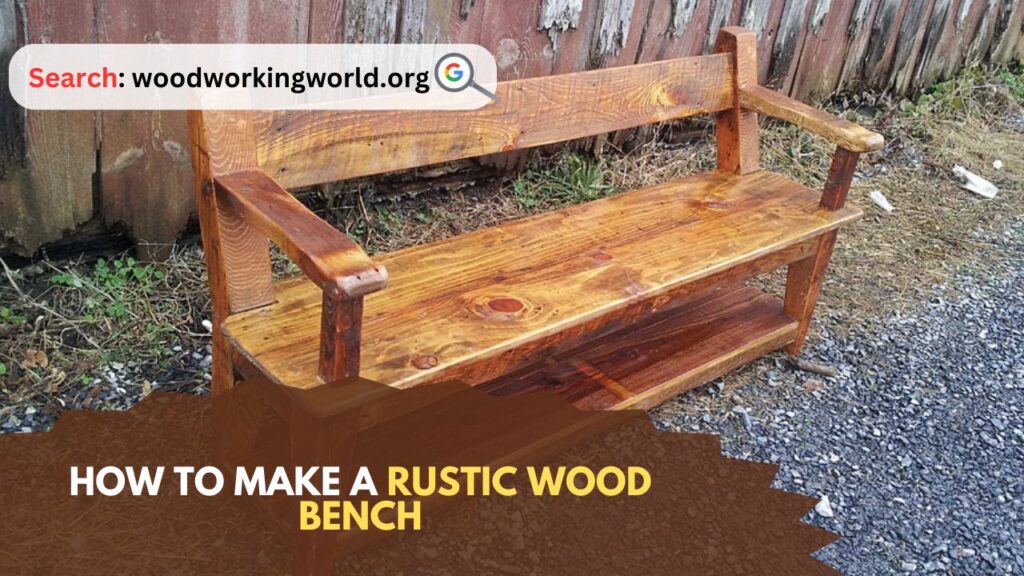Rustic Wood Bench: Creating a rustic wood bench is a rewarding and enjoyable woodworking project that adds charm and functionality to any space. Whether you want to place it in your garden, on your patio, or even in your entryway, a rustic wood bench can enhance the aesthetics of your home with its timeless appeal. In this article, we will guide you through the steps to make your own rustic wood bench, from selecting the right materials to adding the finishing touches.

How to Make a Rustic Wood Bench
Materials and Tools You Will Need
Before you start building your rustic wood bench, gather all the necessary materials and tools:
Materials:
- Lumber: Choose reclaimed or weathered wood for an authentic rustic look. Common types include cedar, pine, or oak. Ensure you have enough for the bench seat, legs, and supports.
- Wood screws or nails: Use appropriate sizes for securing the wood pieces together.
- Wood glue: For additional strength and stability.
- Sandpaper: Various grits (80, 120, 220) for smoothing the wood.
- Wood stain or paint: Choose a color that complements your outdoor or indoor space.
- Polyurethane or outdoor sealant: To protect the wood from the elements.
- Wood filler: For filling any gaps or imperfections.
- Bench cushion (optional): For added comfort.
Tools:
- Measuring tape
- Saw (circular saw, miter saw, or hand saw)
- Drill and drill bits
- Screwdriver or power drill with screwdriver bits
- Clamps
- Carpenter’s square
- Paintbrushes or rags (for staining/painting)
- Safety gear (gloves, safety glasses, dust mask)
Step-by-Step Instructions
Step 1: Plan and Design Your Bench
Start by deciding on the dimensions and design of your rustic wood bench. A standard size for a garden bench is around 48 inches long, 18 inches high, and 14 inches deep. However, you can adjust these dimensions based on your preference and the available space.
Sketch a simple design or find inspiration from online sources. Consider the style of the legs (straight, angled, or X-shaped) and the overall look you want to achieve.
Step 2: Select and Prepare the Wood
Choose reclaimed or weathered wood for a rustic appearance. Inspect the wood for any nails, screws, or defects that need to be removed. If the wood is rough, use a planer or sandpaper to smooth the surface.
Cut the wood to the desired lengths using a saw. For a standard 48-inch bench, you will need:
- One piece for the seat: 48 inches long and 14 inches wide
- Two pieces for the legs: 18 inches long and 3-4 inches wide
- Two pieces for the leg supports: 14 inches long and 3-4 inches wide
- Additional pieces for cross supports, if desired
Step 3: Assemble the Bench Frame
Start by assembling the legs and leg supports. Position the leg supports horizontally between the legs, ensuring they are level and flush with the tops of the legs. Use wood glue and screws or nails to secure the pieces together. Repeat this process for both sets of legs.
Next, attach the seat to the assembled legs. Place the seat on top of the legs, ensuring it is centered and aligned. Use clamps to hold the seat in place while you secure it with screws or nails. For added stability, you can use corner brackets or additional supports underneath the seat.
Step 4: Add Cross Supports (Optional)
For additional strength and a more rustic appearance, consider adding cross supports between the legs. Cut the wood pieces to fit diagonally between the legs and attach them using wood glue and screws. This step is optional but recommended for larger benches or if you prefer a sturdier construction.
Step 5: Sand and Smooth the Wood
Once the bench is assembled, use sandpaper to smooth all the surfaces. Start with a coarse grit (80) to remove any rough spots or splinters, then progress to a finer grit (120) for a smoother finish. Finally, use a very fine grit (220) to achieve a polished surface.
Pay special attention to the edges and corners to ensure there are no sharp or rough areas that could cause injury.
Step 6: Apply Wood Stain or Paint
To enhance the rustic look and protect the wood, apply a wood stain or paint of your choice. Use a paint brush or rag to apply the stain evenly, following the wood grain. Allow the stain to penetrate the wood for the recommended time before wiping off any excess with a clean cloth.
If you prefer a painted finish, apply a primer first, followed by one or two coats of paint. Allow each coat to dry completely before applying the next.
Step 7: Seal the Wood
To protect your rustic wood bench from moisture, UV rays, and other environmental factors, apply a coat of polyurethane or outdoor sealant. Use a paintbrush to apply the sealant evenly, following the manufacturer’s instructions. Allow the sealant to dry completely before using the bench.
Step 8: Add a Bench Cushion (Optional)
For added comfort, consider adding a bench cushion. Choose a cushion that fits the dimensions of your bench and complements the rustic style. Secure the cushion to the bench using ties or non-slip pads.
Tips for a Successful Project
- Choose the right wood: Reclaimed or weathered wood adds character to your bench. Look for wood with interesting grain patterns, knots, and imperfections for a truly rustic look.
- Take your time: Rushing through the project can lead to mistakes and a less polished final product. Take your time with each step to ensure the best results.
- Use quality materials: Invest in good quality wood, screws, and finishes. High-quality materials will ensure your bench is durable and long-lasting.
- Follow safety precautions: Always wear safety gear, such as gloves, safety glasses, and a dust mask, when working with wood and power tools.
- Customize your bench: Feel free to customize the design of your bench to suit your style and needs. You can add armrests, backrests, or decorative elements to make your bench unique.
Maintenance and Care
To keep your rustic wood bench looking its best, follow these maintenance tips:
- Regular cleaning: Wipe down the bench with a damp cloth to remove dirt and debris. Avoid using harsh chemicals that can damage the wood or finish.
- Reapply sealant: Depending on the exposure to the elements, you may need to reapply the sealant every year or two to protect the wood.
- Inspect for damage: Regularly check the bench for any signs of wear, loose screws, or damage. Repair any issues promptly to prevent further damage.
Conclusion: Rustic Wood Bench
Making a rustic wood bench is a fulfilling project that combines creativity, craftsmanship, and functionality. By following these steps and tips, you can create a beautiful and durable bench that enhances your outdoor or indoor space. Enjoy the process of building your bench and the satisfaction of having a unique piece of furniture that reflects your style and skills. Happy woodworking!
I hope this article on Rustic Wood Bench has been helpful. If you have any further questions, please feel free to leave a comment below.
Video
